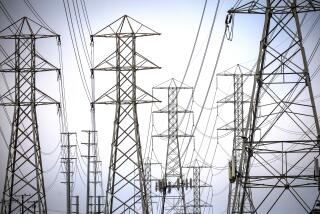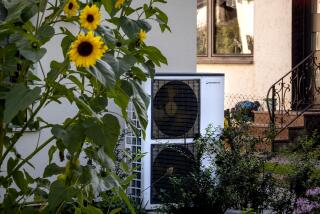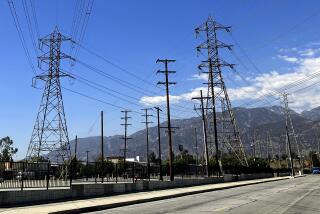Self-Sufficient Homes Breaking New Ground : Energy: Alternative sources of electricity and heat are becoming more sophisticated, but total energy independence is still in the future.
Sylmar residents Ivan and Elke Forbes like being self-sufficient.
A 45-foot wind generator in their back yard services most of their electricity needs. The Forbes family also uses solar panels to heat their water, warm their home and run their refrigerator. When the sun is strong or the wind is really blowing, the Forbeses generate enough power to apply to the Department of Water and Power for a credit on their already low utility bill.
Ted Baumgart and his family in La Crescenta have also whittled down their utility bill with an array of solar panels that heat the pool and spa and that power everything from the refrigerator to an indoor/outdoor train set. The Baumgarts don’t need to worry about heating and cooling bills thanks to concrete floors that were specially designed to keep the home cool in summer and warm in winter. Most of the solar panels--which cost $300 to $350 each--have more than paid for themselves, Baumgart said.
Is energy independence coming to your home soon? Can solar panels and wind generators increase your property values? The answer to these questions is probably no--at least in the near future. Alternative energy technology is becoming more sophisticated, however, and property owners can now at least begin to consider powering their homes without help from an electric or gas company.
Ivan Forbes isn’t sure he has broken even yet on the money he spent on a giant wind generator. He does, however, save a substantial amount of money on his utility bill and he has benefited from both federal and state tax breaks. The system’s $20,000 cost may help explain why the Forbeses are one of the very few families in Southern California to have their home powered by the wind. Forbes says the highest monthly electric bill he gets is $70. Many homeowners also don’t have the space or the inclination or the permission of local authorities to build a silo-like structure in their yard. Because they back up against a power company right-of-way, Ivan Forbes said, he has gotten no complaints from neighbors since erecting the generator more than a decade ago.
The wind generator in Ivan Forbes’ yard looks nothing like the ones you may have seen en route to Palm Springs. Instead, this generator has a round metal frame that lets in wind through vents. The wind then drives a series of spinning buckets. The energy then travels through an electronic system that converts it into AC electricity. The home is also powered with the help of solar panels--also known as photovoltaic panels--which heat both the water and the 2,000-square-foot house.
Of course, solar power has been touted as a wave of the future for about 20 years now. But there are more advanced technologies in use now and already, many solar thermal systems are being used to heat pools, spas and water for home use, said Bob Ellis, president of Environmental Solar Design Inc. in North Hollywood. Solar electric systems--which actually produce electricity, as opposed to solar thermal systems which just heat water--are more expensive and less well-developed, he said. “It’s still a small percentage of the market.”
Ellis, who has been in the solar business for about 10 years, says he does a great deal of his business installing systems to heat pools and spas. “Pools are very expensive to heat,” he said, “so solar panels enable people to better utilize their pool.” A typical solar system costs between $2,500 and $6,000 to install. Not having to use gas or electricity to heat your pool can save $2,500 in the first year alone though. The system works basically by pumping water from the pool through solar panels that attract the heat of the sun. The water circulates during the day and hot water is kept in an insulated holding tank at night.
*
There are various types of solar water heating systems for the home--some with and some without a pump, Ellis explained. The cost is generally about $2,500 to $4,000. The annual utility savings are about $300 to $600 for customers who currently heat their water with gas. The savings will be more significant for people who now heat their water with electricity or propane.
(Incidentally, there is a 10% federal tax credit for business and commercial uses of solar energy. But neither the state of California nor the federal government currently provide tax incentives for residential use of solar panels.)
Homeowners who live in remote parts of the Valley and Ventura County are now being encouraged to use solar power instead of hooking up to a utility. These so-called off-grid customers now qualify for a Southern California Edison program that allows the property owners to lease a solar system with a option to buy. “Homeowners in remote locations can get clean, quiet electricity,” said Wayne Gould, manager of photovoltaic applications for Southern California Edison. “This allows us to provide electrical service to people who haven’t been customers.” He called the solar program a “harmonious marriage between us and third-party power providers who provide solar panels.”
While solar-powered homes can provide much of the electricity needed to run a home, there are very few homes that are totally self-sufficient. This is especially true for residents who want to run lots of appliances at one time. There are a growing number of options though.
One way to learn about some of the options for energy self-sufficiency or so-called renewable energy is by taking a tour of the Forbes home and another energy-independent home in Oxnard. Local tours are being organized from 10 a.m. to 3 p.m. Oct. 15 by Real Goods Trading Corp., a Ukiah-based seller of renewable energy products. More information about the free tours is available by calling (800) 762-7325.
More to Read
Inside the business of entertainment
The Wide Shot brings you news, analysis and insights on everything from streaming wars to production — and what it all means for the future.
You may occasionally receive promotional content from the Los Angeles Times.










